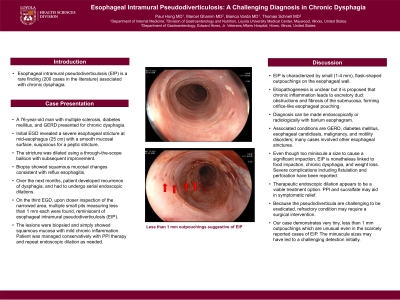Tuesday Poster Session
Category: Esophagus
P3305 - Esophageal Intramural Pseudodiverticulosis: A Challenging Diagnosis in Chronic Dysphagia
Tuesday, October 24, 2023
10:30 AM - 4:00 PM PT
Location: Exhibit Hall

Has Audio

Paul P. Hong, MD
Loyola University Medical Center
Chicago, IL
Presenting Author(s)
Paul P.. Hong, MD1, Marcel Ghanim, MD1, Bianca Varda, MD1, Thomas Schnell, MD2
1Loyola University Medical Center, Maywood, IL; 2Edward Hines Jr. Veterans Affairs Hospital, Hines, IL
Introduction: Esophageal intramural pseudodiverticulosis (EIP) is a rare finding associated with chronic dysphagia.
Case Description/Methods: A 76-year-old man with multiple sclerosis, diabetes mellitus, and GERD presented for chronic dysphagia. Initial EGD revealed a severe esophageal stricture at mid-esophagus (25 cm) with a smooth mucosal surface, suspicious for a peptic stricture. The stricture was dilated using a through-the-scope balloon with subsequent improvement. Biopsy showed squamous mucosal changes consistent with reflux esophagitis. Over the next months, patient developed recurrence of dysphagia, and had to undergo serial endoscopic dilations. On the third EGD, upon closer inspection of the narrowed area, multiple small pits measuring less than 1 mm each were found, reminiscent of esophageal intramural pseudodiverticulosis (EIP). The lesions were biopsied and simply showed squamous mucosa with mild chronic inflammation. Patient was managed conservatively with PPI therapy and repeat endoscopic dilation as needed.
Discussion: EIP is a rare condition of which our knowledge is limited to about 200 cases in the literature. Small (1-4 mm), flask-shaped outpouchings on the esophageal wall are characteristic, and diagnosis can be made endoscopically or radiologically with barium esophagram. Clinical manifestations include dysphagia, food impaction, and weight loss. Etiopathogenesis is unclear but it is proposed that chronic inflammation leads to excretory duct obstructions and fibrosis of the submucosa, forming orifice-like esophageal pouching. Associated conditions are GERD, diabetes mellitus, esophageal candidiasis, malignancy, and motility disorders; many cases involved concomitant esophageal strictures. EIP is suggested to be benign, however, may lead to severe complications including impaction, fistulation, and perforation. Even though too miniscule a size to cause a significant impaction, EIP is nonetheless linked to chronic dysphagia, for which therapeutic endoscopic dilation appears to be a viable treatment option. Because the pseudodiverticula are challenging to be eradicated, significantly distressing condition may require a surgical intervention. PPI and sucralfate may aid in symptomatic relief. Our case demonstrates very tiny, less than 1 mm outpouchings which are unusual even in the scarcely reported cases of EIP. The minuscule sizes may have led to a challenging detection initially. Clinicians must be cognizant of EIP as a differential in chronic dysphagia.
Disclosures:
Paul P.. Hong, MD1, Marcel Ghanim, MD1, Bianca Varda, MD1, Thomas Schnell, MD2. P3305 - Esophageal Intramural Pseudodiverticulosis: A Challenging Diagnosis in Chronic Dysphagia, ACG 2023 Annual Scientific Meeting Abstracts. Vancouver, BC, Canada: American College of Gastroenterology.
1Loyola University Medical Center, Maywood, IL; 2Edward Hines Jr. Veterans Affairs Hospital, Hines, IL
Introduction: Esophageal intramural pseudodiverticulosis (EIP) is a rare finding associated with chronic dysphagia.
Case Description/Methods: A 76-year-old man with multiple sclerosis, diabetes mellitus, and GERD presented for chronic dysphagia. Initial EGD revealed a severe esophageal stricture at mid-esophagus (25 cm) with a smooth mucosal surface, suspicious for a peptic stricture. The stricture was dilated using a through-the-scope balloon with subsequent improvement. Biopsy showed squamous mucosal changes consistent with reflux esophagitis. Over the next months, patient developed recurrence of dysphagia, and had to undergo serial endoscopic dilations. On the third EGD, upon closer inspection of the narrowed area, multiple small pits measuring less than 1 mm each were found, reminiscent of esophageal intramural pseudodiverticulosis (EIP). The lesions were biopsied and simply showed squamous mucosa with mild chronic inflammation. Patient was managed conservatively with PPI therapy and repeat endoscopic dilation as needed.
Discussion: EIP is a rare condition of which our knowledge is limited to about 200 cases in the literature. Small (1-4 mm), flask-shaped outpouchings on the esophageal wall are characteristic, and diagnosis can be made endoscopically or radiologically with barium esophagram. Clinical manifestations include dysphagia, food impaction, and weight loss. Etiopathogenesis is unclear but it is proposed that chronic inflammation leads to excretory duct obstructions and fibrosis of the submucosa, forming orifice-like esophageal pouching. Associated conditions are GERD, diabetes mellitus, esophageal candidiasis, malignancy, and motility disorders; many cases involved concomitant esophageal strictures. EIP is suggested to be benign, however, may lead to severe complications including impaction, fistulation, and perforation. Even though too miniscule a size to cause a significant impaction, EIP is nonetheless linked to chronic dysphagia, for which therapeutic endoscopic dilation appears to be a viable treatment option. Because the pseudodiverticula are challenging to be eradicated, significantly distressing condition may require a surgical intervention. PPI and sucralfate may aid in symptomatic relief. Our case demonstrates very tiny, less than 1 mm outpouchings which are unusual even in the scarcely reported cases of EIP. The minuscule sizes may have led to a challenging detection initially. Clinicians must be cognizant of EIP as a differential in chronic dysphagia.
Disclosures:
Paul Hong indicated no relevant financial relationships.
Marcel Ghanim indicated no relevant financial relationships.
Bianca Varda indicated no relevant financial relationships.
Thomas Schnell indicated no relevant financial relationships.
Paul P.. Hong, MD1, Marcel Ghanim, MD1, Bianca Varda, MD1, Thomas Schnell, MD2. P3305 - Esophageal Intramural Pseudodiverticulosis: A Challenging Diagnosis in Chronic Dysphagia, ACG 2023 Annual Scientific Meeting Abstracts. Vancouver, BC, Canada: American College of Gastroenterology.
